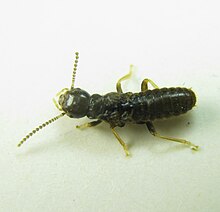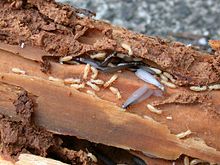
Reticulitermes is a termite genus in the family Rhinotermitidae. They are found in most temperate regions on Earth including much of Asia and the Middle East, Western Europe, and all of North America.
Caste descriptions
Reticulitermes species have three general castes: reproductive, worker, and soldier.
Reproductive caste
In two Reticulitermes species, R. virginicus and R. speratus, mother-son breeding systems have been found. This means their colony members are more related to their mothers than their fathers since 50% of their genotype comes from their mother and 50% from their father who also shares 50% of his genotype with their shared mother. This has shown to bias female alate production over males, likely because colony members favor caring for those who they are most related to (see Kin Selection).
Worker caste
No Reticulitermes species have a true worker caste, meaning that individuals who are not reproductives or soldiers could theoretically become ergatoid reproductives due to the hemimetabolic nature of most termites. Those who do not can either become soldiers or stay workers. These individuals typically focus on brood care and general nest management.
Soldier caste
The soldier caste of most Reticulitermes defend the nest by either using their mandibles to attack invaders or by using their large heads to plug the entrances to their nests. They are most well known for their defensive abilities, though they are known to do many other tasks, such as aiding colony reproduction by accompanying alates and stimulating the production of supplementary reproductives. Like other termite soldiers, they are unable to feed themselves due to their large mandibles.
Many species of Reticulitermes have sex biases in their soldier castes with significantly more female soldiers than males. Some species, like R. virginicus, have next to no male soldiers at all. This is believed to be caused by the sexual dimorphism in termites in which females have a larger size potential than males and the fact that soldiers need to be able to plug entrances with their large heads. However, in R. flavipes, where there is no sexual dimorphism in the reproductive caste, there is also no sex bias in soldier production.
Distribution
In Europe
Reticulitermes flavipes (former santonensis) is found in western France, Reticulitermes grassei in southwestern France, northwestern and southern Spain and Portugal, Reticulitermes banyulensis in the Roussillon region of France and Reticulitermes lucifugus in the Provence region. The subspecies, Reticulitermes lucifugus corsicus is found in Corsica and Sardinia. Reticulitermes urbis, a newly described species is found in urban zones in the southeast of France (Marseille in the west to Italy in the east).
In Asia

Reticulitermes clypeatus is found in Middle East.
Reticulitermes lucifugus is found in Turkey.
Reticulitermes chinensis, Reticulitermes guangzhouensis, Reticulitermes leptomandibularis and Reticulitermes khaoyaiensis are found in China.
Reticulitermes kanmonensis Korea, China and Japan.
Reticulitermes amamianus, Reticulitermes speratus, Reticulitermes miyatakei, Reticulitermes okinawanus and Reticulitermes yaeyamanus are found in Japan.
Reticulitermes arenincola is found in India.
Reticulitermes speratus is also found in all place in South Korea as well as Japan and North Korea
In North America
The eastern subterranean termite (Reticulitermes flavipes) is the most widely distributed termite found in the eastern United States. R. flavipes is commonly found in southern Ontario, and is found in all the eastern states including Texas, extending as far south as Mexico City and as far west as Arizona, with likely accidental introductions on the west coast of the US.
Other termites found there are the dark southeastern subterranean termite (Reticulitermes virginicus) and the light southeastern subterranean termite (Reticulitermes hageni). These are less important economically (such as in damage to crops) because of their more limited range.
Other termites species are found: Reticulitermes hesperus in California; Reticulitermes malletei in Mississippi; Reticulitermes nelsonae in Louisiana and Florida.
In medical research
The extended longevity of social insect queens is of interest because it implies the presence of an anti-aging mechanism. Long-lived queens of Reticulitermes speratus have markedly less oxidative damage to their DNA than non-reproductive individuals (workers, soldiers and nymphs). Queens have more than twice the catalase activity and seven times higher levels of expression of the catalase gene RsCAT1 than workers, soldiers and nymphs. Catalase catalyzes the decomposition the reactive oxygen species hydrogen peroxide, and protects against oxidative stress. It appears that the extended longevity of R. speratus queens is partially explained by their efficient antioxidant capability.
References
- "Reticulitermes santonensis".
- "GENUS Reticulitermes". UniProt. Retrieved 21 October 2012.
- ^ Lainé, L.V.; Wright, D.J. (July 2003). "The life cycle of Reticulitermes spp. (Isoptera: Rhinotermitidae): what do we know?". Bulletin of Entomological Research. 93 (4): 267–278. doi:10.1079/BER2003238. ISSN 0007-4853. PMID 12908912.
- Kobayashi, Kazuya; Hasegawa, Eisuke; Yamamoto, Yuuka; Kawatsu, Kazutaka; Vargo, Edward L.; Yoshimura, Jin; Matsuura, Kenji (October 2013). "Sex ratio biases in termites provide evidence for kin selection". Nature Communications. 4 (1): 2048. Bibcode:2013NatCo...4.2048K. doi:10.1038/ncomms3048. hdl:2123/11211. ISSN 2041-1723. PMID 23807025. S2CID 14636330.
- Korb, Judith (2008). "Termites, hemimetabolous diploid white ants?". Frontiers in Zoology. 5 (1): 15. doi:10.1186/1742-9994-5-15. ISSN 1742-9994. PMC 2564920. PMID 18822181.
- Korb, J.; Buschmann, M.; Schafberg, S.; Liebig, J.; Bagneres, A.-G. (7 July 2012). "Brood care and social evolution in termites". Proceedings of the Royal Society B: Biological Sciences. 279 (1738): 2662–2671. doi:10.1098/rspb.2011.2639. ISSN 0962-8452. PMC 3350695. PMID 22398169.
- Matsuura, Kenji (1 January 2002). "Colony-level stabilization of soldier head width for head-plug defense in the termite Reticulitermes speratus (Isoptera: Rhinotermitidae)". Behavioral Ecology and Sociobiology. 51 (2): 172–179. doi:10.1007/s00265-001-0426-2. ISSN 0340-5443. S2CID 43740455.
- Prestwich, G D (January 1984). "Defense Mechanisms of Termites". Annual Review of Entomology. 29 (1): 201–232. doi:10.1146/annurev.en.29.010184.001221. ISSN 0066-4170.
- Tian, Li; Zhou, Xuguo (2014). "The Soldiers in Societies: Defense, Regulation, and Evolution". International Journal of Biological Sciences. 10 (3): 296–308. doi:10.7150/ijbs.6847. ISSN 1449-2288. PMC 3957085. PMID 24644427.
- Bordereau, Christian (1985), "The Role of Pheromones in Termite Caste Differentiation", Caste Differentiation in Social Insects, Elsevier, pp. 221–226, doi:10.1016/b978-0-08-030783-1.50021-5, ISBN 9780080307831, retrieved 10 July 2019
- Lüscher, Martin (1961). Social Control of Polymorphism in Termites. Royal entomological society.
- Haverty, M. I. (1977). "The proportion of soldiers in termite colonies: a list and a bibliography (Isoptera)". Sociobiology (USA).
- Matsuura, Kenji (2 November 2006). "A novel hypothesis for the origin of the sexual division of labor in termites: which sex should be soldiers?". Evolutionary Ecology. 20 (6): 565–574. Bibcode:2006EvEco..20..565M. doi:10.1007/s10682-006-9117-9. ISSN 0269-7653. S2CID 24359010.
- Clément, J.-L.; Bagnères, A.-G.; Uva, P.; Wilfert, L.; Quintana, A.; Reinhard, J.; Dronnet, S. (2001). "Biosystematics of Reticulitermes termites in Europe: Morphological, chemical and molecular data". Insectes Sociaux. 48 (3): 202–215. doi:10.1007/PL00001768. S2CID 35077778.
- Leniaud, L.; Dedeine, F.; Pichon, A.; Dupont, S.; Bagneres, A.G. (2010). "Geographical distribution, genetic diversity and social organization of a new European termite, Reticulitermes urbis (Isoptera: Rhinotermitidae)". Biological Invasions. 12 (5): 1389–1402. Bibcode:2010BiInv..12.1389L. doi:10.1007/s10530-009-9555-8. S2CID 29252890.
- Kim, M.J.; Choi, Y.S.; Lee, J.; Kim, J.J.; Kim, G.H. (2012). "Molecular Characteristics of Subterranean Termites of the genus Reticulitermes (Isoptera: Rhinotermitidae) From Korea". Annals of the Entomological Society of America. 105: 97–102. doi:10.1603/AN11078. S2CID 85816528.
- Park, Y.C.; Kitade, O.; Schwarz, M.; Kim, J.P.; Kim, W. (2006). "Intraspecific molecular phylogeny, genetic variation and phylogeography of Reticulitermes speratus (Isoptera : Rhinotermitidae)". Molecules and Cells. 21 (1): 89–103. doi:10.1016/s1016-8478(23)12906-2. PMID 16511351.
- Austin, J.W.; Bagneres, A.G.; Szalanski, A.L.; Scheffrahn, R.H.; Heintschel, B.P.; Messenger, M.T.; Clement, J.L.; Gold, R.E (20 August 2007). "Reticulitermes malletei (Isoptera : Rhinotermitidae): a valid nearctic subterranean termite from eastern North America" (PDF). Zootaxa. Magnolia Press: 1–26. ISSN 1175-5326. Retrieved 24 August 2023.
- ^ Tasaki E, Kobayashi K, Matsuura K, Iuchi Y (2017). "An Efficient Antioxidant System in a Long-Lived Termite Queen". PLOS ONE. 12 (1): e0167412. Bibcode:2017PLoSO..1267412T. doi:10.1371/journal.pone.0167412. PMC 5226355. PMID 28076409.
